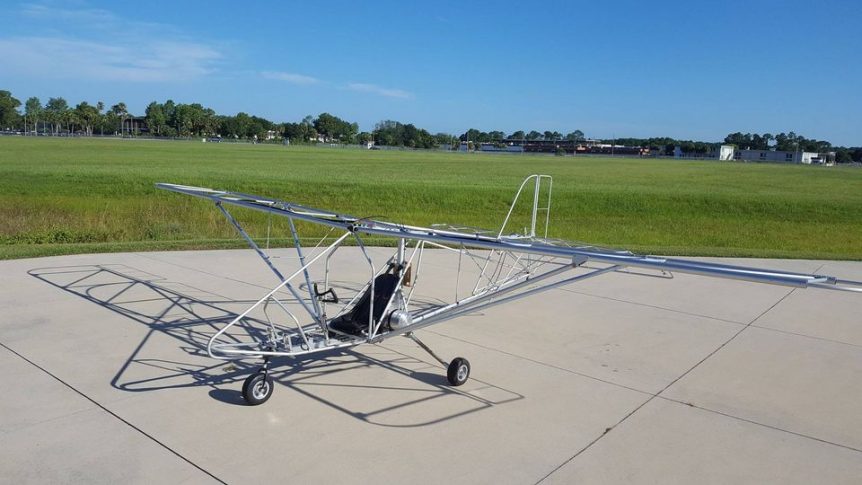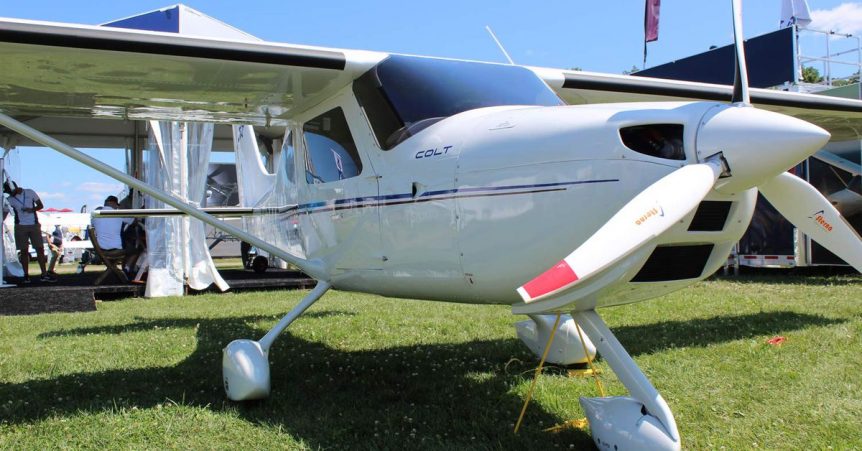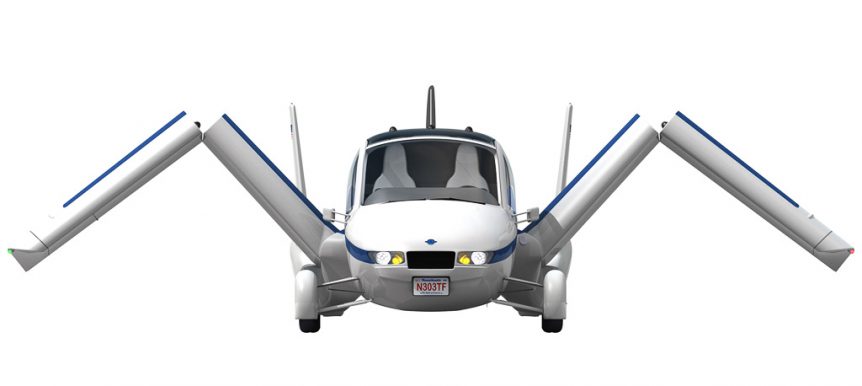Shown and flown at this year’s Sun ‘n Fun and AirVenture, the Aerolite 103 is a well-tested, best-selling ultralight that in FAA Part 103 form is a true ultralight. As an electric aircraft, it’s heavier and faster than accepted ultralight standards but no less a competent flyer registered in the Experimental category. Designed in 1996, and with hundreds of the original two-stroke engine-powered versions flying, Aerolite’s originator Terry Raber sold the rights to Dennis Carley in 2012. Manufacturing moved from Millersburg, Ohio to Delano, Florida. The airplane retains its position as an inexpensive FAA Part 103-compliant ultralight – true to its name. In the last few years, it has also become part of zero-emission flight. Aerolite as an EV One can only wonder where Gabriel DeVault finds the time. Currently working in Hollister, California and Cirencester, England on ZeroAvia’s hydrogen-fueled aircraft, Gabriel was also powerplant developer for Zero Motorcycles. His motors now power several homebuilt aircraft, including his personal eGull …
Electric Colt Introduced at Oshkosh
Texas Aircraft hails from its development and production facility at South Texas Regional Airport in Hondo, Texas. Designed in Brazil, their Colt Light Sport Aircraft is built by American veterans. Constrained by LSA design criteria, the craft is the high-wing representation of what we have come to expect from the Pipistrel Alpha Trainer, the Vashon Ranger, and others of the type. It has the almost mandatory Rotax engine, but will soon fly fume-free with a Siemens motor. With the two-seat aircraft already flight tested in Brazil and its American version being built and flown here, the Colt’s introduction at AirVenture included a glimpse of its alternate power plant, a Siemens SP-55D producing 72 kilowatts (96.5 horsepower) AT 3,000 rpm. Matheus Grande, co-founder of the Hondo-based firm, told Flying magazine, “The availability to offer a version of our new Colt LSA powered by a new-generation Siemens eAircraft electric motor will give both private owners and flight schools the option of having …
Geely Looks Skyward, Buys Terrafugia
Geely is a huge enterprise, and while not the largest maker of electric cars in China, sold 766,000 gas and electric vehicles in 2016, growing 50 percent over the previous year. Its profits grew 126 percent last year, primarily due to sports utility vehicle (SUV) sales. As EV Obsession reports: “The 351,861 electric car sales registered in China during 2016 represent approximately 46% of ALL plug-ins sold worldwide this year, with Chinese carmakers responsible for 43% of all EV production in 2016.” Geely, surprisingly, owns Lotus, Malaysia’s Proton Motors, the firm that makes London’s iconic taxis, and Volvo. Volvo just announced that all its cars will be electric or hybrid starting in 2019. Fortune reports that the company has become highly profitable, with 2016 net returns doubling to 5.1 billion yuan ($741 million), and possibly rising to 7 billion yuan in 2017. What is a successful company to do with all that money? The South China Morning Post reports on one …
China Permits Two-Seat Electric Aircraft
Jane Zhanf of Silk Wings Aviation (see note), an aircraft consulting firm, commented on an earlier post about the RX1E, an airplane designed by Shenyang University students and demonstrated at two airshows over the last two years. Similar to the Yuneec (GreenWings) E430, it is a totally different design. “CAAC (Civil Aviation Administration of China) just awarded[a]TDA (Type Design Approval) to them! “By the way, Yuneec E430 is not widely known in China, not an excuse for the wrong claim of being #1 from China though. (Editor’s Note: The E430 is being developed by GreenWings, now based in California. It uses a Yuneec motor.) “Given FAA and EASA don’t support electric SLSA (Special Light Sport Aircraft – allowed to be used for instruction by the FAA) yet (correct me if wrong), RX1E maybe world first “certified” electric LSA.” The European Aviation Safety Agency (EASA) has apparently allowed flights by the Pipistrel WattsUp at the Blois, France fly-in last year and demonstrations …
EAS VIII: Joby Motors – on Simple and Complex Airframes
JoeBen Bevirt, founder and CEO of Joby Aviation, Joby Motors, and related enterprises, has thought long and hard about the financial costs and lost productivity brought about by the daily automotive commute, a 1.6 hour per day ordeal for many in our urban centers. JoeBen and the Atlantic magazine agree that commuters squander 5.5 billion hours and 2.9 billion gallons of fuel annually, stuck in the fitful despair of slow or unmoving traffic, sharing only frustration and polluted air with their fellow motorists. JoeBen told attendees at the April Electric Aircraft Symposium that several years before, he had the seeming pipe dream of moving people by air in a single-seat, eight-motorm, vertical takeoff and landing, electric commuter aircraft that would take one 100 miles at 100 miles per hour for one dollar. The combination of Greg Cole’s Sparrowhawk and electric power focused too much on efficiency, according to JoeBen, and battery technology had not evolved to allow the practical outcome …
EAS VIII: Across the Atlantic – Twice
Jean-Luc Soullier, holder of Fédération Aéronautique Internationale records for speed and altitude in an aircraft almost lighter than its pilot, has a greater series of ambitions to expand the range and speed of electric aircraft. Having stretched the limits of his Colomban MC-30e with two different motors, he’s looking at a longer-spanned, cleaner aircraft – the Windward Performance Duckhawk – as a means of getting higher speed and much longer range for a truly formidable (tres formidable) crossing of the Atlantic Ocean, not once, but twice. The airplane, with a Rotex motor on the nose and a specially-designed Arplast three-bladed propeller, will weigh a mere 105 kilograms (231 pounds) empty – without batteries. This is considerably less than the lightest Duckhawk in standard form, and shows that designer Greg Cole and Jean-Luc are making room for the added weight of long-range energy storage. Since the original airplane manages +7.5/-5 g’s, the lighter version will be restricted to a never-exceed velocity …
Randall Fishman’s ElectraFlyer ULS – a Gateway Plane
Appearing before attendees at the 2013 Electric Aircraft Symposium, Randall Fishman’s spoke of great accomplishments and grander visions. “ElectraFlyer ULS & Electric Ultralight Airplanes, the path to approval for all electric aircraft?” showed ElectraFlyer’s history and the ambitions Randall would like to play out. A pioneer in ultralights, Randall has been flying hang gliders since 1972, produced the first continuously powered electric aircraft, flew the first electric airplane at Oshkosh’s AirVenture and claims a primary interest of bringing practical, user-friendly electric flight to as many people as possible. Between 2005 and 2007, he designed, built and test flew his first electrically-powered trike. Making its first take-off on April 29, 2007, by May 2 it had made a one-hour flight. Ever more venturesome, Randall modified a Moni motorglider with an electric motor and flew that at AirVenture in 2008, for which he won both the Stan Dzik Memorial Award for innovation and the Dr. August Raspet Memorial Award for “outstanding contribution to …
The G4 Gets Off the Grass
Pipistrel had a good week at Oshkosh. Shortly after its G4 placed ninth in the Dead Grass Awards, an indication of the number of spectators who tramped around the perimeter of the displayed aircraft, the company could announce the first test flight of the four-seat electric motorglider. “We are pleased to announce that after long and demanding work nearly of a nearly 30-member team of developers and constructors from Pipistrel’s R & D Institute the first 4-seat electric aircraft in the world took off this morning [August 12, 2011] at 7 AM local time.” Pipistrel overcame several difficulties in achieving this milestone. Developing the electric power system, the most powerful currently in an aircraft, and importing the 450 pounds of lithium-polymer batteries needed to energize it presented many issues. Perhaps the utterly new and unique design and the possibility of that many batteries self-igniting caused insurance companies to be more than normally cautious, although one did finally step forward. Because …
Richard VanGrunsven on Electric Airplanes
Despite having produced kits which have led to 6,410 RV aircraft in the air at last count – all carbon-consuming and emitting lightplanes – Richard VanGrunsven owns an electric airplane, an Antares 20E self-launching sailplane. He attended AirVenture 2009, and reports on his findings regarding the current crop of electric airplanes in his article “The Year of the Electric Airplane.” His opinions are worth noting, simply because of the worldwide acceptance of his designs. He obviously loves his Antares, noting its single-lever motor operation as “almost sinfully simple” compared to the more complex extension/motor start/operation/shutdown/retraction sequences on other motorgliders. He shows some disappointment in the low performance speeds of present electrically-powered craft, but notes that if the claims of some motor packages were fulfilled, “I’d run right out and get a ‘plug-and-play’ motor system and design an airplane around it.” Now, that’s an incentive for developers!
Electrify Your Reading Pleasure
Flying Magazine, in its November issue, has its usual stunning photo review of this year’s AirVenture at Oshkosh, Wisconsin, but adds a three-page review of the electric aircraft that showed up at the fly-in. Robert Goyer, senior editor, is enthusiastic about the planes he saw, and gives the largest number of column inches to Yuneec’s E-430 two-seater. Goyer has reservations about the aircraft’s performance and limited range, and turns to another Yuneec-powered craft, Tom Pehigny’s FlightStar e-Spyder, propelled by a 27 hp, single-battery pack system, with the assessment that this type of craft seems more suited to electric power in its current state of development. Although Pehigny admits restrictions in terms of range so far, he “does point out some benefits we can see already. The e-Spyder…is whisper-quiet, smooth-running, dirt simple to start and smoke and odor-free.” Goyer includes a brief note on Randal Fishman’s Electra-Flyer C and new two-seater X, but gives little detail on either. Goyer foresees a …



